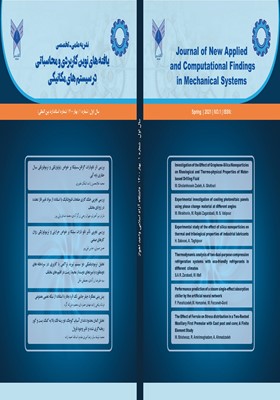پیش بینی عملکرد چیلر جذبی تک اثره بخار با استفاده از شبکه عصبی مصنوعی
محورهای موضوعی : یافته های نوین کاربردی و محاسباتی در سیستم های مکانیکیفرشاد پناهی زاده 1 , مهدی حمزه ای 2 , محمود فرزانه گرد 3
1 - گروه مهندسی مکانیک، واحد اهواز، دانشگاه آزاد اسلامی، اهواز، ایران
2 - گروه مهندسی مکانیک، واحد اهواز، دانشگاه آزاد اسلامی، اهواز، ایران
3 - گروه مهندسی مکانیک، دانشگاه فردوسی مشهد، مشهد، ایران
کلید واژه: شبکه عصبی مصنوعی, یلر جذبی تک اثره, میانگین مربع خطا, ضریب عملکرد,
چکیده مقاله :
چیلرهای جذبی تک اثره با توجه به دما و فشار منبع حرارتی مورد استفاده به دو نوع تک اثره آب گرم و بخار تقسیم می شوند. که نوع تک اثره بخار آن به دلیل توانایی استفاده از بخار دور ریز در صنایع نفت، گاز و پتروشیمی جهت تولید سرمایش فرآیندی و تهویه مطبوعی دارای کاربرد بیشتری است. در تحقیق حاضر در خصوص پیش بینی عملکرد چیلر جذبی تک اثره بخار از شبکه عصبی مصنوعی استفاده شده که نسبت به روشهای مدلسازی ترمودینامیکی دارای سرعت بالاتر و هزینه محاسباتی کمتری است. شبکه عصبی پرسپترون چند لایه با الگوریتم پس انتشار خطا، تابع محرک تانژانت هیپربولیک و روش آموزش لونبرگ-مارکوارت با تعداد 15285 داده و شاخص ارزیابی میانگین مربع خطا بکار برده شده است. ورودی های شبکه عصبی مصنوعی به ترتیب دمای آب برج خنک کننده ورودی، دمای آب سرمایشی ورودی، دمای بخار ورودی، دمای آب سرمایشی خروجی و راندمان مبدل حرارتی محلول هستند و خروجی های شبکه عصبی نیز ضریب عملکرد و انرژی حرارتی مصرفی چیلر می باشند. نتایج حاصل از تحقیق حاضر نشان می دهند که روش شبکه عصبی مصنوعی توانایی پیش بینی ضریب عملکرد و انرژی حرارتی مصرفی چیلر جذبی تک اثره را با میانگین مربع خطا به ترتیب 7-10×183/3 و 8-10×466/7 دارا می باشد که حاکی از دقت بالای این روش در پیش بینی عملکرد چیلر جذبی است.
Depending on the temperature and pressure of the heat source, single-effect absorption chillers are categorized in two types of hot water and steam single-effect chillers. Due to the ability to use the waste steam in oil, gas and petrochemical industries for air conditioning and process cooling purposes, the steam type chiller is more widely used. In this study, the artificial neural network is exploited in the prediction of the steam single-effect absorption chiller performance since it is faster and has lower computational cost compared to thermodynamic modeling methods. The perceptron multilayer neural network with the error backpropagation algorithm, the hyperbolic tangent excitation function and the Levenberg-Marquardt learning method with 15285 data points and also the mean squared error estimation index are used. Inputs of the artificial neural network are the inlet cooling tower water temperature, inlet chilled water temperature, inlet steam temperature, outlet chilled water temperature and the solution heat exchanger efficiency respectively. Also, outputs of the neural network are the coefficient of performance and thermal energy consumption of the chiller. Results of this study show that the artificial neural network is capable to predict the coefficient of performance and the thermal energy consumed by the single-effect absorption chiller while the values of mean squared error are 3.183×10^(-7) and 7.466×10^(-8) respectively which verify the accuracy of the method proposed here in absorption chiller performance prediction.
1. Panahizadeh, F., Hamzehei, M., Farzaneh-Gord, M., Ochoa, A. A. V., (2020), Energy, Exergy, Economic Analysis and Optimization of Single-Effect Absorption Chiller Network, Journal of Thermal Analysis and Calorimetry, pp 1-31.
2. Panahizadeh, F., Hamzehei, M., Farzaneh-Gord, M., Ochoa. A. A. V., (2021), Numerical Study on Heat and Mass Transfer Behavior of Pool Boiling in LiBr/H2o Absorption Chiller Generator Considering Different Tube Surfaces, Thermal Science, 25(2B), pp 1599-1611.
3. Panahizadeh, F., Hamzehei, M., Farzaneh-Gord, M., Ochoa, A. A. V., (2021), Thermo-Economic Analysis and Optimization of the Steam Absorption Chiller Network Plant, Thermal Science, pp 1-12.
4. Karasuyama, M., Inoue, K., Nakamura, R., Kandori, H., Takeuchi, I., (2018), Understanding Color Tuning Rules and Predicting Absorption Wavelengths of Microbial Rhodopsins by Data-Driven Machine-Learning Approach, Scientific Reports 8.
5. Farzaneh-Gord, M., Mohseni-Gharyehsafa, B., Arabkoohsar, A., Ahmadi, M. H., Sheremet, M. A., (2020), Precise Prediction of Biogas Thermodynamic Properties by Using ANN Algorithm, Renewable Energy 147, pp 1-13.
6. Qian, F., Gao, W., Yang, Y., Yu, D. (2020), Potential Analysis of the Transfer Learning Model in Short and Medium-Term Forecasting of Building H.V.A.C. Energy Consumption, Energy 193, pp 116724.
7. Mu, B., Li, Y., House, J.M., Salsbury, T.I., (2017), Real-Time Optimization of a Chilled Water Plant with Parallel Chillers Based on Extremum Seeking Control, Applied Energy 208, pp 1-16.
8. Park, S., Ahn, K. U., Hwang, S., Choi, S., Park, Ch. S., (2019), Machine Learning Vs. Hybrid Machine Learning Model for Optimal Operation of a Chiller, Science and Technology for the Built Environment 205, pp 1-12.
9. Nasruddin., S., Alhamid., M. I., Saito., K., (2018), Hot Water Temperature Prediction Using a Dynamic Neural Network for Absorption Chiller Application in Indonesia, Sustainable Energy Technologies and Assessments 30, pp 1-7.
10. Nasruddin., A. N., Alhamid. M.I., Saha. B. B., Sholahudin. S., Lubis. A., (2019), Solar Absorption Chiller Performance Prediction Based on the Selection of Principal Component Analysis, Case Studies in Thermal Engineering 13.
_||_

